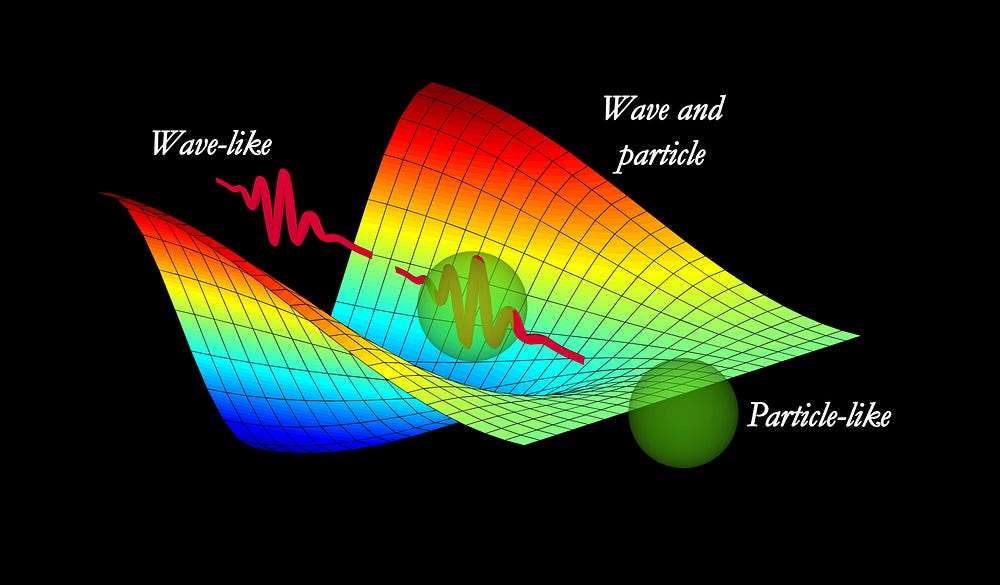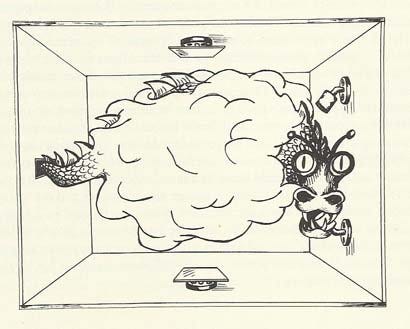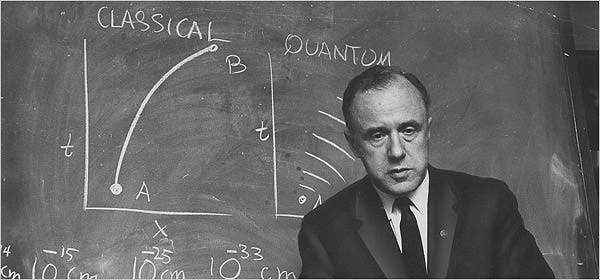The primary problem is that of thinking of quantum particles as classical particles which nonetheless behave in very non-classical ways. (Alternatively, the problem is thinking of quantum particles as what Michael Brooks calls “objects” in the first place.) Many of the examples of quantum “weirdness” stem from that fact — at least those weird things which belong to the many and various interpretations of quantum mechanics. Yet whatever it is that quantum physicists deal with, it isn’t equivalent to classical objects or even equivalent — or similar — to particles of dust, sand or glass. (Here’s Carlo Rovelli playing down quantum weirdness.)
Quantum particles are staggeringly smaller than classical particles. Unbelievably so. And because of that, almost (to use Philip Ball’s words) “everything is different” (i.e., not simply weird) at the quantum scale. This means that using words like “object”, “particle”, etc. problematises things. And even the quantum-mechanical word “wave” is often misleading. That’s primarily because quantum waves are something presented purely by equations - they’re not, strictly speaking, descriptions of parts of reality. (Here’s Lee Smolin playing down quantum weirdness.)
More specifically, if particles are waves, then (wave) interference isn’t really that weird at all. And superposition isn’t that weird either. (That said, seeing a quantum x as a wave is also problematic — as stated a moment ago.)
Technically, a quantum x (i.e., something not as yet given a name) and a quantum y interfere with each other — just like waves on the sea. Thus when quantum x and quantum y interfere, they create a superposition. Of course a classical object can’t interfere with another classical object — at least not in the same quantum sense or way. And neither can a classical x and classical y be in a state of superposition.
Yet we’re not talking about classical objects — or even classical particles - here!
Thus why should it be weird that a quantum x doesn’t behave like a classical object or even a classical particle? In reverse, if a classical object were to behave like a quantum x, then that would be weird. But that doesn’t happen. So many people believe that quantum phenomena are weird mainly because they see them as classical phenomena which nonetheless behave in very non-classical ways. Yet, in actual fact, we only have quantum phenomena behaving in quantum ways — just as classical phenomena behave in classical ways.
And again Michael Brooks shows us the problem with the word “particle” when he uses the words “a single positive nuclear charge, or proton”. Here we surely have a statement of identity. Thus:
proton = (a single) positive nuclear charge
Thus a particle in this case is simply a positive charge. Now a positive (or negative) charge is hardly particle-like — at least when taken on its own. And even if there’s more to a proton (or another particle) than its positive charge (such as spin, mass, size, etc.), the word “particle” still seems inappropriate… yet also useful!
If we return to waves, one way (among many) to get the point across is to state that the de Broglie wavelength of a fullerene molecule (made up of 60 atoms!), which is a large quantum “object”, is around 10–¹² metres, or a thousand billionth of a metre! Now how on earth can that have anything to do with a wave on the sea or with any other kind of classical (or macro) wave?
The following discussion is as close as we can come to a classical particle in quantum mechanics.
When Waves Become Particles

As already hinted at, when two quantum waves interact with one another, they produce a superposition. That superposition is the sum of the waves at any given point. Moreover, that “sum” is more particle-like than the two waves as they were before they became a sum. (This is roughly in line with Max Born’s 1920s/30s position — see ‘Born rule’.) This particle-like something is the (as it were) massy result of the sum of two — or more — quantum waves. In other words, if you stick one trough and another trough together (or one peak and another peak together), then you get something particle-like or massy. Alternatively put, waves become more (as it were) solid when squashed, fused or mixed together…
Of course all these words and descriptions are largely analogical in nature!
In other words, the words “wave” and “particle” (along with “trough” and “peak”, never mind “squashed”, “fused” and “mixed”) are still being used here. And that primarily because I have no choice but to do so.
Indeed all these words belong to the interpretation of quantum mechanics. This means that simply using the bald variables x, y and so on isn’t really of much help when it comes to interpreting quantum mechanics. And it certainly won’t help any vaguely-interested layperson.
The Great Smoky Dragon’s Body

Despite the earlier passage from Michael Brooks, he states the following words elsewhere in the same book:
“The ultimate reality behind Schrödinger's wave equation was neither wave nor particle, Bohr felt, and so could not be described in any terms we can deal with.”
Of course Brooks merely putting Niels Bohr’s position doesn’t also mean that he agrees with it. Still, Bohr did pick up an a problem that needs addressing — even if one needn’t accept his overall position or interpretation. (Many did disagree with Bohr — notably such physicists as Albert Einstein and, later, David Bohm.)

The American theoretical physicist John Archibald Wheeler (1911–2008) also picked up on these — or at least similar — problems. He used the image of a “great smoky dragon” to get his point across. That is, he stated that “we have no right to speak about what is present” in between experimental inputs and experimental outputs (or observations). Thus words like “particle” and “wave” are automatically suspect — at least when used about this experimental (as it were) in between (i.e., the supposed “reality” of the dragon’s body).
So there’s a distinction to be made here between describing a quantum x as a “particle” or “wave” before the output (i.e., what exists and happens before the actual experiment or observation) and describing that x in that way after there is an experimental or observational output. However, perhaps it’s still problematic to use these classical words even when an experiment (or observation) has been carried out — or when a quantum wave function has been “collapsed”.
Take Bohr’s position again. According to Brooks, Bohr believed that
“once a measurement is made, the type of measurement will determine what we see”.
What’s more,
“[i]f you use an instrument that detects something’s position is space, for instance, you’ll see something that has a definite position in space — the entity that we call a particle”.
The point here is that the use of the word “particle” to refer to something (as it were) on the dragon’s body, and also to refer to something after “an instrument that detects something’s position is space”, are both suspect. So it’s not only that this (noumenal?) x isn’t a particle before detection or observation — it isn’t even a particle after detection (or observation) either.
To sum up: the classical word “particle” is problematic in all quantum cases.
Note:
If it’s problematic to see quantum particles as particles (or objects), then that’s even partially true of atoms too.
Perhaps a single atom can’t be seen as a single “object” at all. After all, if the nucleus of, say, a helium atom is seen as being the size of a lemon, then the edge of that atom (which is defined by the outer orbit of its electrons) would be 2.5 miles in diameter. Proportionately, then, the nucleus is staggeringly disproportionate to the seize of the entire atom. And each electron within the atom is unbelievably smaller than the atom to which it belongs. (It’s equivalent to a pencil dot within a 2.5 mile diameter.)
Of course most/all (classical) entities are also constituted by separate elements — so this isn’t in itself problematic.









No comments:
Post a Comment